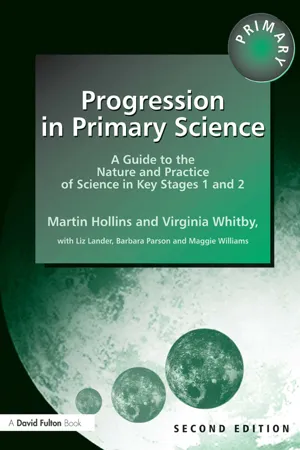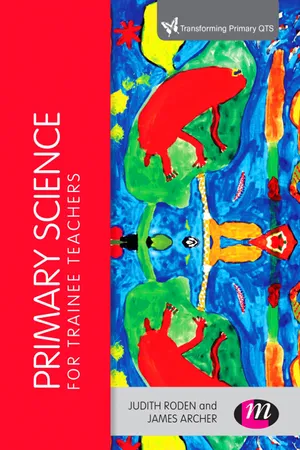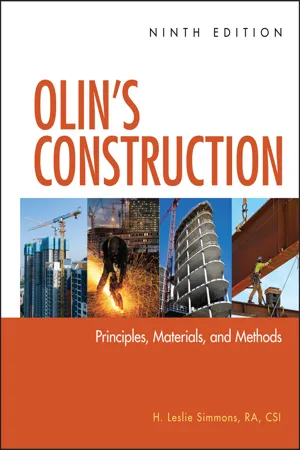Physics
Materials
In physics, materials refer to substances used to construct objects or systems. They can be classified as metals, ceramics, polymers, and composites based on their properties and atomic structure. The study of materials involves understanding their behavior under different conditions and their applications in various fields such as engineering, technology, and manufacturing.
Written by Perlego with AI-assistance
Related key terms
Related key terms
1 of 4
Related key terms
1 of 3
7 Key excerpts on "Materials"
- eBook - ePub
Progression in Primary Science
A Guide to the Nature and Practice of Science in Key Stages 1 and 2
- Martin Hollins, Maggie Williams, Virginia Whitby(Authors)
- 2013(Publication Date)
- David Fulton Publishers(Publisher)
Chapter 3 Materials and their PropertiesIntroduction
The opportunities for both the pupil and the teacher for the exploration of Materials in the primary school are all-encompassing. For whatever the child is investigating, whether it be a specifically scientific topic like forces or electricity, or some other curricula topic where any tangibles are concerned, then 'Materials' will be involved, simply because the Earth and everything on it are made of Materials. 'Materials' includes all of the Materials of which things are composed, i.e. natural Materials, such as rocks and air; Materials that have been made from other Materials, such as glass; and those which make up living things, such as teeth and bones.The term 'Materials' is often used in a rather limited sense by children for things like fabrics and building Materials. Teachers need to develop and extend the children's perception of the word 'material' through the exploration of a large range of experiences with Materials which will extend their understanding and allow them to differentiate between an object and the material of which it is made. In scientific terms, the word 'material' is used widely to include liquids and gases as well as solid Materials. There is a huge variety including naturally occurring Materials like rock, wood and bone, traditional ones such as stone and glass, as well as modern Materials including plastics. The creation and use of collections of Materials in the classroom provides opportunities to investigate similarities and differences between Materials. 'Feely bags' are particularly useful for encouraging children to consider the relative properties of Materials (e.g. smoothness, hardness, etc.) without the distraction of actually seeing the object. - eBook - ePub
- Milton Ohring(Author)
- 2001(Publication Date)
- Academic Press(Publisher)
Chapter 1 A Review of Materials Science1.1 INTRODUCTION
A cursory examination of the vast body of solid substances reveals what outwardly appears to be an endless multitude of external forms and structures possessing a bewildering variety of properties. The branch of study known as Materials Science evolved in part to classify those features that are common among the structure and properties of different Materials in a manner somewhat reminiscent of chemical or biological classification schemes. This dramatically reduces the apparent variety. From this perspective, it turns out that solids can be classified as belonging typically to one of only four different categories (metallic, ionic, covalent, van der Waals) depending on the nature of the electronic structure and resulting interatomic bonding forces. Another scheme based on engineering use would again arguably limit Materials to four chief classes, namely, metals, semiconductors, polymers, and ceramics.Similar divisions occur with respect to structure of solids. Solids are either internally crystalline or noncrystalline. Those that are crystalline can be further subdivided according to one of 14 different geometric arrays or lattices depending on the placement of the atoms. When properties are considered, there are similar descriptors and simplifying categorizations. Thus, Materials are either good, intermediate, or poor conductors of electricity, they are either mechanically brittle or can easily be stretched without fracture, they are either optically reflective or transparent, etc. It is, of course, easier to recognize that property differences exist than to understand why they exist. Nevertheless, much progress has been made in this subject as a result of the research of the past century. Basically, the richness in the diversity of Materials properties occurs because countless combinations of the admixture of chemical compositions, bonding types, crystal structures, and morphologies either occur naturally or can be synthesized. - eBook - ePub
- Judith Roden, James Archer(Authors)
- 2014(Publication Date)
- Learning Matters(Publisher)
7 Everyday Materials: Their Uses, Properties and Changes of MaterialsLearning Outcomes
By reading this chapter you will develop:- your awareness of the properties of Materials and how Materials can be used;
- an understanding of the processes that can be used to assist the separation of Materials;
- an ability to explain the differences between physical and chemical changes;
- an awareness of effective pedagogic strategies for teaching about Materials.
Teachers' Standards
- 1. Set high expectations which inspire, motivate and challenge pupils
- set goals that stretch and challenge pupils of all backgrounds, abilities and dispositions.
- 3. Demonstrate good science subject and curriculum knowledge
- have a secure knowledge of science and the science curriculum, foster and maintain pupils’ interest in the subject, and address misunderstandings.
- 4 . Plan and teach well-structured lessons
- promote a love of learning and children's intellectual curiosity.
Introduction
Materials are genuinely amazing! Taught well this area of science enthuses, engages and excites children. But what do we mean by Materials and how are they made? Let's start at the very beginning. Scientists have determined that the entire universe including the Earth is made up of a total of 92 elements. When we are talking about everything we can hear, smell, touch, taste and see, and some things that we can't, the fact that it takes only 92 different naturally occurring elements to create these things is mind blowing. Materials are made up of elements which are the building blocks of Materials. Many elements are able to combine chemically with others in different ratios to form a whole host of molecules.Atoms are some of the smallest units of matter. They are the smallest particle that can be divided by normal procedures. The word atom derives from two ancient Greek words meaning ‘no-division’. It is widely known that hydrogen atoms and oxygen atoms together form molecules of water in a ratio of two hydrogen to one oxygen atom (H2 - eBook - ePub
Olin's Construction
Principles, Materials, and Methods
- H. Leslie Simmons(Author)
- 2011(Publication Date)
- Wiley(Publisher)
A material's suitability for a particular use depends on its ability to perform satisfactorily under the conditions to be encountered. When a material's properties are known, its performance in a particular situation can be predicted. The four general groups of properties of interest to those in the construction industry are mechanical, thermal, electrical, and chemical properties. Each depends on the composition of the material in question.The millions of Materials in our universe are all made from just three basic building blocks: atoms, ions , and molecules . These are bonded together by one of several basic chemical bonds. Materials can be classified according to these basic structural elements and bonds into three major categories with different properties:1. Ceramics and glasses —hard, brittle, poor conductors of heat and electricity2. Metals —more ductile than ceramics, good conductors of heat and electricity3. Molecular Materials —low melting temperatures, fair strength, poor conductors of heat and electricitySince all construction Materials fall into one of these three categories, a greater understanding of such Materials can be obtained by recognizing the category in which a particular material belongs and remembering the properties of that category. For instance, glass wool and foamed polystyrene may have identical insulating capabilities, but the glass wool falls into the ceramic category and the foam into the molecular category. From that knowledge a designer can surmise, without seeing manufacturers' specifications for the Materials, that the foam will have a lower melting temperature than the glass wool, because the melting temperatures of molecular Materials is lower than that of ceramic Materials .This chapter is intended to expand and sharpen the reader's instinct for categorizing Materials. First, the basic structure of matter is discussed; then the four sets of properties that determine a material's performance are considered in some detail. For more information about the properties of a particular material, refer to the chapter in which that specific material is discussed.23.1 Structure of Matter Matter is formed by the chemical bonding of atoms, ions, and molecules. The particular combination of components and bonding methods determines final material properties. - eBook - ePub
Materials Enabled Designs
The Materials Engineering Perspective to Product Design and Manufacturing
- Michael Pfeifer(Author)
- 2009(Publication Date)
- Butterworth-Heinemann(Publisher)
Chapter 4. Material Properties and Materials Science 4.1. Introduction This chapter explains the relationship between a material's properties, composition, and microscopic structures. Brief discussions of the Materials science of different types of Materials are provided. The discussions illustrate some of the many ways that composition and microscopic structures can be manipulated to achieve the desired properties. (Conversely, there are also many ways that the composition and microscopic structures, and resulting properties, can be compromised.) This chapter also provides information about available sources of Materials science and engineering information. Although it is not the purpose of this book to teach Materials science, some degree of knowledge about it is required to understand the relationship between properties, composition, microscopic structures, and manufacturing processes, and to better appreciate the Materials engineering perspective. The Materials science information presented barely scratches the surface of each topic; however, what is here should be sufficient to provoke a healthy respect for the complexity of Materials and the science related to them. The discussions should help dispel the myths that decisions about Materials can be made intuitively and that common Materials are not without their own intricacies. 4.2. Material Properties and Material Features As discussed in the previous chapter, the performance and reliability of a product element depends on the properties of the Materials from which it is made. The properties of any material depend on its various features—composition and microscopic structures. The composition of a material refers to the atomic elements and compounds that make up a material. Different elements, mixtures of elements, and compounds have different properties. The intrinsic properties of any material depend on its composition - eBook - ePub
- Joseph Angelo(Author)
- 2020(Publication Date)
- Facts On File(Publisher)
Foundations of Materials Science and Engineering. 5th ed. New York: McGraw-Hill, 2006. Provides scientists and engineers of all disciplines an introduction to Materials science, including metals, ceramics, polymers, and composite Materials. Technically knowledgeable laypersons will find the treatment of specific topics such as biological Materials useful.Strathern, Paul. Mendeleyev's Dream: The Quest for the Elements. New York: St. Martin's Press, 2001. Describes the intriguing history of chemistry from the early Greek philosophers to the 19th-century Russian chemist Dmitri Mendeleyev.Thrower, Peter, and Thomas Mason. Materials in Today's World. 3rd ed. New York: McGraw-Hill Companies, 2007. Provides a readable introductory treatment of modern Materials science, including bioMaterials and nanoMaterials.Trefil, James, and Robert M. Hazen. Physics Matters: An Introduction to Conceptual Physics. New York: John Wiley & Sons, 2004. Highly-readable introductory college-level textbook that provides a good overview of physics from classical mechanics to relativity and cosmology. Laypersons will find the treatment of specific topics useful and comprehendible.Zee, Anthony. Quantum Field Theory in a Nutshell. Princeton, N.J.: Princeton University Press, 2003. A reader-friendly treatment of the generally complex and profound physical concepts that constitute quantum field theory.Web Sites
To help enrich the content of this book and to make your investigation of matter more enjoyable, the following is a selective list of recommended Web sites. Many of the sites below will also lead to other interesting science-related locations on the Internet. Some sites provide unusual science learning opportunities (such as laboratory simulations) or in-depth educational resources.American Chemical Society (ACS) is a congressionally chartered independent membership organization that represents professionals at all degree levels and in all fields of science involving chemistry. The ACS Web site includes educational resources for high school and college students. Available online. URL: http://portal.acs.org/portal/acs/corg/content - eBook - ePub
- Sharon Ann Holgate(Author)
- 2021(Publication Date)
- CRC Press(Publisher)
Box 4.1 reveals, very carefully chosen Materials are needed to withstand the rigours of containing a plasma in a fusion reactor.FIGURE 4.1 This close-up image shows the “Materials on International Space Station Experiment-8”. Taken during the spacewalk on July 12, 2011, the small circles pictured are test beds for Materials and computing elements attached to the outside of the International Space Station. These elements are being evaluated for the effects of atomic oxygen, ultraviolet, direct sunlight, radiation, and the extremes of heat and cold. Researchers hope the results will provide a better understanding of the durability of various Materials and computing elements when they are exposed to the rigors of space environments and hope to incorporate what is learned into the design of future spacecraft. (Figure caption text and image © NASA.)In Section 5.3, we will learn about thermal properties such as expansion and thermal conduction, and see how these macroscopic properties affect Materials choice. Electrical conduction and superconductivity are covered in Chapter 6 , including a look at superconductor technology. Optical and piezoelectric properties are discussed in Chapter 7 , while magnetism and its technological applications are explored in Chapter 8 .No matter what other qualities a material requires, its mechanical properties—such as hardness and elasticity—are generally important for any application. This is because Materials are usually subjected to some sort of force during their working lives.In the first section of this chapter, we will see how several of the main mechanical properties are measured and why they are of interest. We will also look at ways in which the mechanical properties of solids can be altered or supplemented for particular applications.
Index pages curate the most relevant extracts from our library of academic textbooks. They’ve been created using an in-house natural language model (NLM), each adding context and meaning to key research topics.
Explore more topic indexes
Explore more topic indexes
1 of 6
Explore more topic indexes
1 of 4






